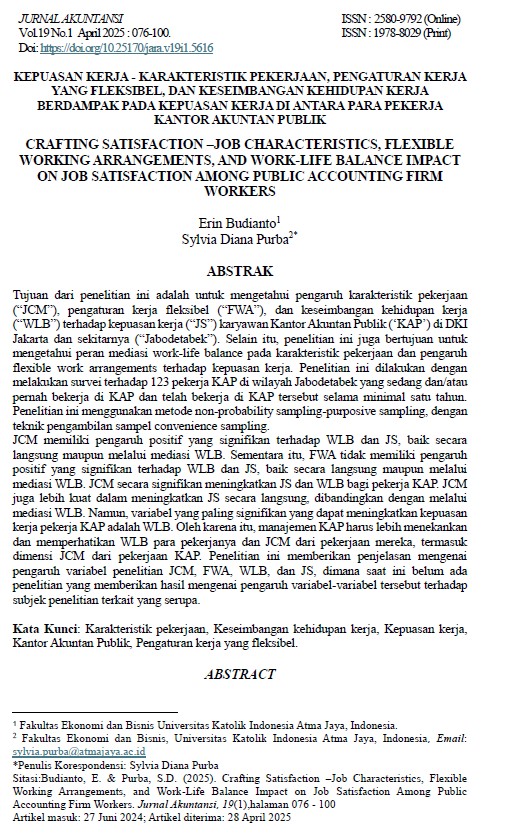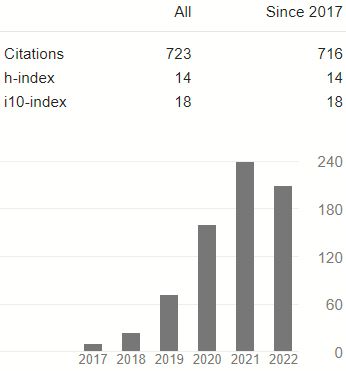CRAFTING SATISFACTION –JOB CHARACTERISTICS, FLEXIBLE WORKING ARRANGEMENTS, AND WORK-LIFE BALANCE IMPACT ON JOB SATISFACTION AMONG PUBLIC ACCOUNTING FIRM WORKERS
DOI:
https://doi.org/10.25170/jak.v19i1.5615Keywords:
Flexible working arrangement, Job characteristics, Job satisfaction, Public Accounting Firm , Work-life balanceAbstract
The purpose of this research was to determine the influence of job characteristics (“JCM”), flexible work arrangements (“FWA”), and work-life balance (“WLB”) on job satisfaction (“JS”) of Public Accounting Firm (“KAP”) workers in DKI Jakarta and its surrounding areas (“Jabodetabek”). Apart from that, this research also aimed to determine the mediating role of work-life balance on job characteristics and flexible work arrangements' influence on job satisfaction. This research was conducted by surveying 123 KAP workers in the Jabodetabek area who are currently and/or have worked with FWA and have worked at KAP for at least a year. This research uses a non-probability sampling method—purposive sampling, with a convenience sampling technique.
JCM has a significant positive influence on WLB and JS, both directly and through WLB mediation. Meanwhile, FWA does not have a significant positive influence on WLB and JS, either directly or through WLB mediation. JCM significantly increases JS and WLB for KAP workers. JCM can also be more potent in improving JS directly, compared to through WLB mediation. However, the most significant variable that can increase job satisfaction of KAP workers is WLB. Therefore, KAP management should emphasize and pay more attention to the WLB of their workers and the JCM of their work, including the JCM dimensions of KAP work. This research provides an explanation of the influence of the research variables JCM, FWA, WLB, and JS , where currently, no research has provided results on the influence of these variables on similar related research subjects.
References
Bakarich, K. M., Marcy, A. S., & O’Brien, P. E. (2022). Has the fever left a burn? a Study of the impact of COVID-19 remote working arrangements on public accountants’ burnout. Accounting Research Journal, 35(6), 792–814. https://doi.org/10.1108/ARJ-09-2021-0249
Bellmann, L., & Hübler, O. (2020). Working from home, job satisfaction and work–life balance – robust or heterogeneous links? International Journal of Manpower, 42(3), 424–441. https://doi.org/10.1108/IJM-10-2019-0458
Direktorat Jenderal Kekayaan Negara (2020). Bekerja dari Rumah (Work from Home) dari Sudut Pandang Unit Kepatuhan Internal. Access 10 Mei 2023, Bekerja dari Rumah (Work From Home) Dari Sudut Pandang Unit Kepatuhan Internal (kemenkeu.go.id)
Fisher, G. G., Bulger, C. A., & Smith, C. S. (2009). Beyond work and family: a Measure of work/nonwork interference and enhancement. Journal of Occupational Health Psychology, 14(4), 441–456. https://doi.org/10.1037/a0016737
Hair, J. F., Risher, J. J., Sarstedt, M., & Ringle, C. M. (2019). When to use and how to report the results of PLS-SEM. European Business Review, 31(1), 2–24. https://doi.org/10.1108/EBR-11-2018-0203
Hopkins, J., & Bardoel, A. (2023). The future is hybrid: How organisations are designing and supporting sustainable hybrid work models in post-pandemic Australia. Sustainability (Switzerland), 15(4). https://doi.org/10.3390/su15043086
Jamal, M. T., Anwar, I., Khan, N. A., & Saleem, I. (2021). Work during COVID-19 : Assessing the influence of job demands and resources on practical and psychological outcomes for employees. https://doi.org/10.1108/APJBA-05-2020-0149
Kementerian Kesehatan Republik Indonesia (2020). Tanya jawab coronavirus disease (COVID-19) - QnA Update 6 Maret 2020. Diakses 8 Mei 2023, Infeksi Emerging Kementerian Kesehatan RI (kemkes.go.id)
Kementerian Keuangan Republik Indonesia (2020). New Normal di tengah pandemi covid-19. Diakses 8 Mei 2023, New Normal di Tengah Pandemi Covid-19 (kemenkeu.go.id)
Krajčík, M., Schmidt, D. A., & Baráth, M. (2023). Hybrid work model: an Approach to Work–Life Flexibility in a Changing Environment. Administrative Sciences, 13(6). https://doi.org/10.3390/admsci13060150
Kutllovci, E., & Zhushi, G. (2022). E-work evaluation through work – life balance , job effectiveness, organizational trust and flexibility : Evidence from Kosovo during COVID-19. 44(2), 371–385. https://doi.org/10.1108/ER-04-2021-0136
Mary, S. (2021). There is a time and a place for work : Comparative evaluation of flexible work arrangements in Canada. 42(1), 167–192. https://doi.org/10.1108/IJM-12-2019-0555
McKinsey and Company (2021). What executives are saying about the future of hybrid work. Access 16 Mei 2023, What executives are saying about the future of hybrid work | McKinsey
Morgeson, F. P., & Humphrey, S. E. (2006). The Work Design Questionnaire (WDQ): Developing and validating a comprehensive measure for assessing job design and the nature of work. Journal of Applied Psychology, 91(6), 1321–1339. https://doi.org/10.1037/0021-9010.91.6.1321
Nurmayanti, S., Sakti, D. P. B., & Rinuastuti, B. H. (2022). Pengaruh work from home terhadap work life balance pada perempuan bekerja di Kota Mataram di masa pandemi covid-19. Jurnal Sosial Ekonomi dan Humaniora, 8(2), 306–311. https://doi.org/10.29303/jseh.v8i2.52
Palumbo, R., Flamini, G., Gnan, L., Pellegrini, M. M., & Petrolo, D. (2021). Disentangling the implications of teleworking on work – life balance : a Serial mediation analysis through motivation and satisfaction. https://doi.org/10.1108/JOEPP-08-2020-0156
Paul E. Spector. (1997). Job satisfaction survey. University of South Florida: Department of Psychology. https://www.researchgate.net/profile/Jeevan-Jyoti-3/post/How-to-measure-job-satisfaction-level-of-employees/attachment/59d6454479197b80779a067a/AS%3A452468732633089%401484888360166/download/JssEnglish+%281%29.pdf
Peprah, E. O. (2023). Hybrid workplace : Current status , positives , negatives , challenges , and team learning. https://doi.org/10.1108/TLO-11-2022-0150
Rai, A. (2021). Exploring the mediating role of work engagement between the linkages of job characteristics with organizational engagement and job satisfaction. 44(1), 133–157. https://doi.org/10.1108/MRR-10-2019-0442
Rashmi, K., & Kataria, A. (2021). The mediating role of work-life balance on the relationship between job resources and job satisfaction : Perspectives from Indian nursing professionals. https://doi.org/10.1108/IJOA-04-2021-2722
Sawalha, N., Kathawala, Y., & Magableh, I. (2019). Educator organizational citizenship behavior and job satisfaction moderation in the GCC expatriate-dominated market. International Journal of Organizational Analysis, 27(1), 19–35. https://doi.org/10.1108/IJOA-09-2017-1247
Sulistyo, H. (2017). Studi Turnover Auditor Kantor Akuntan Publik di Indonesia Berdasarkan Jenis Kelamin, Tingkat Pendidikan, Jabatan dan Kota. Jurnal Ekonomi Manajemen dan AKuntansi, 43, 49–58.
Thiagaraj, D., & Thangaswamy, A. (2017). Theoretical Concept of Job Satisfaction - a Study. International Journal of Research -GRANTHAALAYAH, 5(6), 464–470. https://doi.org/10.29121/granthaalayah.v5.i6.2017.2057

Downloads
Published
Issue
Section
License
Copyright (c) 2025 Erin Budianto, Sylvia Diana Purba

This work is licensed under a Creative Commons Attribution-ShareAlike 4.0 International License.
Authors who publish with this journal agree to the following terms:
- Authors retain copyright and grant the journal right of first publication with the work simultaneously licensed under a Creative Commons Attribution-ShareAlike 4.0 International License that allows others to share the work with an acknowledgment of the work's authorship and initial publication in this journal.
- Authors are able to enter into separate, additional contractual arrangements for the non-exclusive distribution of the journal's published version of the work (e.g., post it to an institutional repository or publish it in a book), with an acknowledgment of its initial publication in this journal.
- Authors are permitted and encouraged to post their work online (e.g., in institutional repositories or on their website) prior to and during the submission process, as it can lead to productive exchanges, as well as earlier and greater citation of published work.














